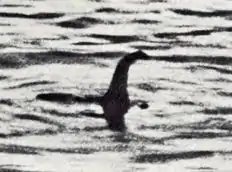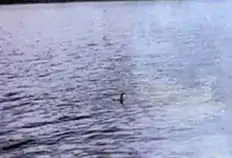Loch Ness Monster
The Loch Ness Monster (nicknamed "Nessie") is a shy vermiform beast supposedly roaming the murky depths of Scotland's Loch Ness, making the odd teasing surface appearance only to shaky-handed photographers with poorly-focused cameras. Hoax photographers and others of limited vision tend to cast the dreadful Orm as a plesiosaur, making it more attractive to a juvenile audience (leaving aside the fact that plesiosaurs were physically incapable of holding their neck in the manner depicted). The reality of it is far more horrible than most folk are able to stomach; do not try to imagine a giant aquatic centipede
| Part of RationalWiki's Cryptid Petting Zoo |
| Hiding with Schrödinger's cat |
v - t - e |
“”I don't know anything about zoology, biology, geology, geography, marine biology, cryptozoology,evolutionary theory, evolutionary biology, meteorology, limnology, history, herpetology, palaeontology or archaeology. But I think: what if a dinosaur had got in the lake? |
| —Stewart Lee |
Nessie is worth a small fortune to the Scottish tourism industry in general, and to the economies of Inverness and the Highlands in particular. It should therefore be treated as a fact, not a scam, and all scepticism should be put aside for the greater good of the puir wee bairns. Cryptozoology anyone? At least not believing in it doesn't incur eternal consequences, unlike many other things.
Some people attempt to trace it back to Saint Columba's encounter with a water-monster, supposedly dated to August 22, 565 CE, while he was travelling Scotland converting people; Columba told the beast to get lost when it attacked one of his followers.
Surgeon's photograph


The most famous photograph of the Loch Ness Monster is the "Surgeon's Photo", taken by Colonel Robert Wilson, a surgeon (actually a gynaecologist, but that might get unexpected search results) in the British Army in 1934. Although somewhat convincing in the cropped version, a full-sized version of the photograph eventually emerged showing that the "head" of the monster was actually remarkably small. It was later revealed to be a complete hoax.[1]
Other photographs
In June 2020, a photo circulated across the Internet of the Loch Ness Monster, "proving" it exists. The Syracuse [2], the Daily Mail [3] (some never learn ) and Forbes [4] all reported it, though Forbes and Syracuse tried to put a little bit of skepticism, they mostly had the article filled with speculation. However, this photo was disproven after people matched the "monster" with an Italian catfish.
Plausibility
While there has been much debunking done on individual pieces of evidence like the above Surgeon's photo, and plenty of searches to outright prove that there's nothing there, few people ever bother to consider whether such a creature like Nessie could even plausibly exist. If Nessie, as in popular culture, was a plesiosaur or some other Mesozoic marine reptile, she would need to frequently surface for air. Loch Ness may be one of the largest freshwater bodies in Europe, but it's not big enough for something of Nessie's size to hide while doing this; after all, we see dolphins and whales pop up quite regularly in much lower population densities. To quote Skeptoid on the subject,[5]
“”A breeding population necessary for minimal genetic diversity would require at least 100 individuals. This means that there should be a minimum of several thousand heads popping up per day for air. Given that there are so few sightings, in light of the number of eyes watching the loch every day, the possibility that any air-breathing yet unseen animals are in the loch becomes vanishingly small. |
In other words, "Nothing to see here, go on about your business. Human well-being is only affected by other air-breathing vertebrates with a vanishingly small number of exceptions."
Even if the hypothetical creature weren't an air breather, there's the additional problem of food supply. Loch Ness has hardly any fish in it larger than your thumb, and is too deep for sunlight to penetrate to the lakebed (thus little to no vegetation grows in it). A breeding population of giant underwater monsters, even assuming they were cold-blooded, would have to eat hundreds of times the weight of all available life in the lake, just to survive.
The other plausible explanation is that it's not that big. A DNA study by Otago University found the most likely candidate was an eel, although they reluctantly admitted the largest eel ever caught in Europe weighed an un-monstrous 5.38kg. Prof Neil Gemmell, head of the study, conceded, "It is possible there are very large eels, but it depends how big you think 'large' is."[6]
Similar beasts
Jealous of Loch Ness, other Scottish bodies of water have claimed their own cryptids. Morag in Loch Morar has been observed several times over 100 years, upending a boat carrying two drunken fishermen in 1969, and last spotted in 2013.[7] Otters may be responsible. Muc-sheilche
Kelpie
Some cryptozoologists have speculated that the legend of the monster could be connected to earlier stories of a Kelpie
This kelpie had been in the habit of appearing as a beautiful black horse, finely caparisoned, on a well-frequented road in the Highlands. By his winning ways he allured unwary travellers to mount him. No sooner had the weary, unsuspecting victim seated himself in the saddle than away darted the horse with more than the speed of the hurricane, and plunged into the deepest part of Loch Ness, and the rider was never more seen.
It is often said that the monster was never seen until 1934, which seems good evidence of its invention in that year by Colonel Robert Wilson. But it may be influenced by older myths.[9]
See also
- The creature's actual disgusting appearance, extrapolated from The Great Orm of Loch Ness[10]
References
- Museum of Hoaxes - Surgeon's Photo
- []
- []
- []
- Skeptoid - The Loch Ness Monster
- Loch Ness monster could be a giant eel, say scientists, The Guardian, 5 Sep 2019
- "Tourists' shock as Morag of Loch Morar – Scotland's second most famous monster – makes a comeback after 20 years", The Daily Record, 25 August 2013
- See the Wikipedia article on List of Scottish loch-monsters.
- Was Nessie a Kelpie?, StrangeHistory.net, 22 Dec 2013
- Holiday, F.T. The Great Orm of Loch Ness (Faber and Faber 1968)